Checklist for AI-Optimized Irrigation
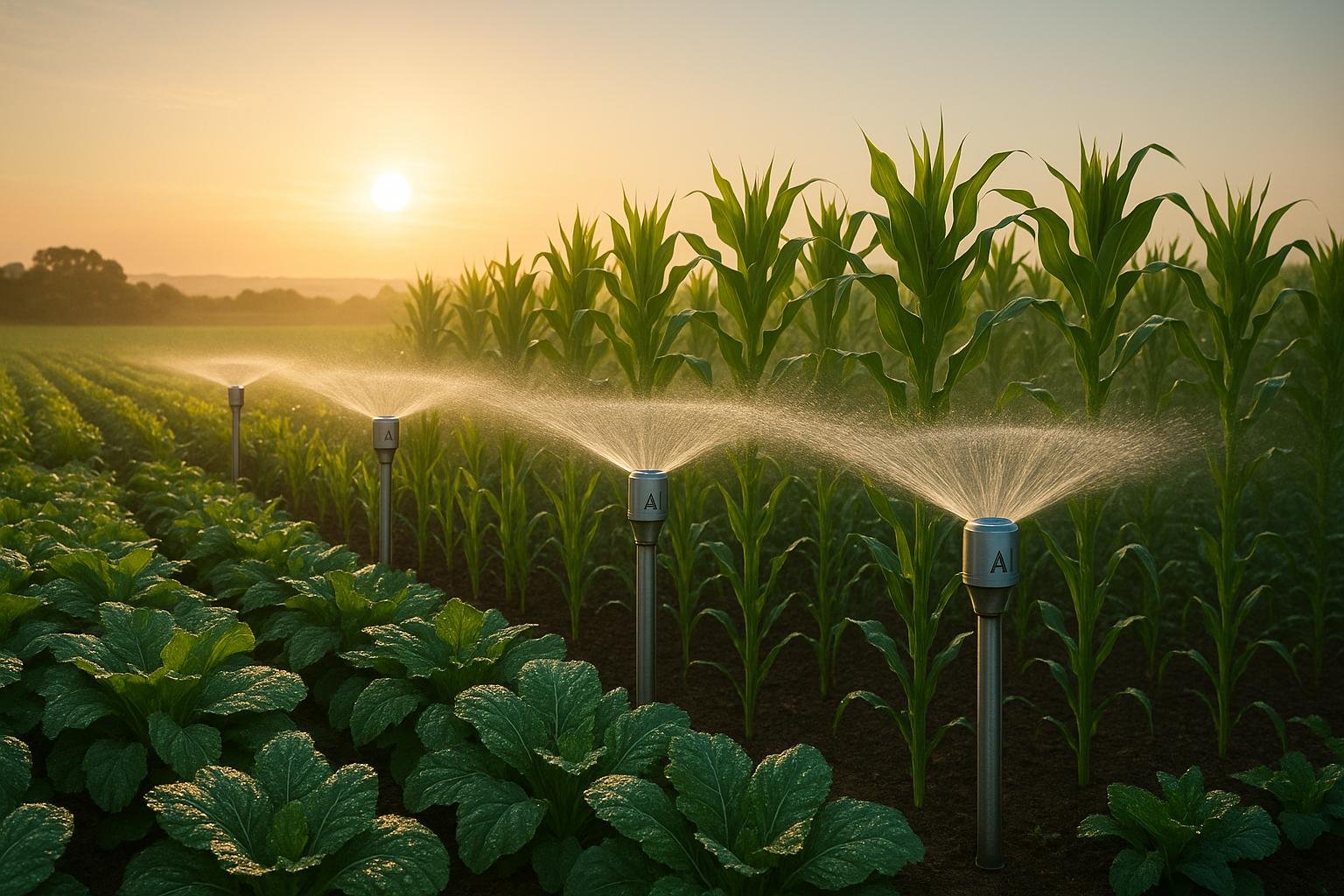
AI irrigation systems are transforming water use in agriculture and gardening. These systems use real-time data from sensors, weather forecasts, and satellite imagery to maximize efficiency. Here’s what you need to know:
- Save Water: Cut water use by up to 50% with 85–95% efficiency compared to 60–70% for traditional methods.
- Boost Yields: Increase crop yields by 20–30% while reducing production costs by 10–20%.
- Easy to Use: Sync with mobile apps to monitor and control watering remotely.
- Key Components: Smart controllers ($250–$2,500), soil moisture sensors ($99–$1,800), and weather tools ($30–$200).
- Setup Tips: Install sensors in key areas, ensure strong internet connectivity, and follow local regulations.
AI Controlled Smart Irrigation System

Quick Comparison
| Feature | Traditional Irrigation | AI-Powered Irrigation |
|---|---|---|
| Water Efficiency | 60–70% | 85–95% |
| Water Savings | Minimal | Up to 50% |
| Crop Yields | Standard | 20–30% higher |
| Cost Savings | Limited | 10–20% lower |
| Ease of Use | Manual adjustments | Automated, app-controlled |
AI irrigation systems offer significant water savings, improved crop health, and lower costs, making them a practical solution for farms and gardens alike.
Required Components for AI Irrigation Systems
Building an AI-powered irrigation system involves combining specific hardware and software to achieve efficient water management. Many systems are designed to work seamlessly with existing U.S. irrigation setups, making upgrades relatively simple for homeowners and commercial users alike.
Key System Components
The centerpiece of any AI irrigation system is the smart controller, which processes data and makes real-time decisions about watering schedules. These advanced controllers replace traditional timers, adjusting irrigation based on environmental conditions. Costs for climate-based controllers range from $250 to $900, while professional-grade ET controllers can cost between $900 and $2,500.
Soil moisture sensors are another essential component. Installed 6–12 inches below the surface, these sensors provide precise data to fine-tune irrigation. Individual sensors are priced between $99 and $165, while complete systems can range from $280 to $1,800. Research shows that soil moisture controllers can cut irrigation use by an average of 72% compared to manual scheduling.
To further optimize efficiency, weather monitoring tools are often included. Rain sensors, which prevent watering during rainfall, are available in wireless models ($120–$200) or wired versions ($30–$50). Wind sensors, typically bundled with other monitoring tools, cost around $80 to $100 and help minimize water waste in windy conditions that promote evaporation.
Lastly, internet connectivity is crucial for tying all these components together. It enables remote updates, real-time adjustments, and seamless performance.
Installation Requirements
Installing AI irrigation systems in the U.S. generally follows standard electrical and plumbing guidelines, with a focus on correct placement and power connections. Smart controllers are usually plugged into standard 120V outlets and integrated with existing irrigation valve systems.
For soil moisture sensors, placement is key. Install them in representative areas of the landscape, ensuring they are at least 3 feet away from sprinkler heads, tree roots, sidewalks, and walls. Rain sensors should be mounted in open spots where they can accurately detect rainfall.
Before starting any installation, call 811 to have underground utilities marked. This step helps avoid accidental damage to gas, electric, or water lines. Also, check local building codes to ensure compliance with backflow prevention regulations, as these requirements vary by municipality.
"A smart controller will make poor design, installation and maintenance practices even more obvious. Smart controller accessories can provide additional opportunities to avoid potential water waste", says Don Davis, irrigation training manager at SiteOne Landscape Supply.
For a smooth setup, consider hiring a WaterSense-certified irrigation professional. They can ensure proper system integration and compliance with local regulations. Additionally, verify that the controller location has a strong internet signal, as weak connectivity can disrupt system performance.
Once the hardware is in place, the next step is selecting the right software to maximize your system’s potential.
Choosing AI-Compatible Tools
With the hardware set up, it’s time to choose software that complements your AI irrigation system. For instance, Phytech’s AI-powered advisor uses IoT sensor data to provide field-specific watering recommendations.
"With Phytech AI Advisor, we're giving farmers a super-intelligence that grows with their trees... They will never grow alone again", explains Oren Kind, CEO of Phytech.
For broader agricultural needs, Fasal offers an IoT-SaaS platform that combines sensors, AI algorithms, and data analytics. It provides real-time insights into crop health and integrates with farm management software via mobile apps. Similarly, Farmonaut uses satellite-based crop monitoring and AI-driven advisory systems to guide irrigation decisions based on weather patterns and satellite data.
When selecting AI-compatible tools, consider your operation’s size, budget, existing infrastructure, and the level of technical support available. Look for software that offers features like soil moisture integration, weather forecast connectivity, and automated scheduling. Ensuring compatibility with your current equipment is also critical to avoid unnecessary complications.
Tailor your system’s capabilities to your specific needs. For smaller gardens, basic smart controllers with weather integration might suffice. Larger commercial operations, on the other hand, may benefit from more advanced platforms with satellite monitoring and predictive analytics.
🚀 Ready to Reinvent Your Garden?
Join thousands of homeowners who have transformed their gardens using our AI design tool. Upload one photo to explore endless possibilities.
Get your AI garden designs →Pre-Operation Checklist
Before you activate your AI irrigation system, it’s crucial to perform a thorough pre-operation inspection. This ensures everything runs smoothly and helps you avoid costly issues down the line.
Inspect Water Source and Pressure
Your system’s efficiency depends heavily on a reliable water supply and proper pressure levels. Start by checking your primary water source - whether it’s a main line, well, or rain barrels.
To test water pressure, use a pressure gauge. Most systems require 30–50 PSI for optimal performance. It’s best to measure in the morning, as that’s when water pressure is typically at its lowest. Be sure to test both sides of the hose bib on your backflow device.
If the pressure is too low, check if your main or shut-off valve is fully open. Partially closed valves are a common issue, especially after recent construction work. Also, inspect for underground leaks and confirm that your backflow valve is functioning properly.
For high pressure, consider adding pressure regulators to protect your system’s components. If the pressure is too low, look for potential restrictions in your supply line that may need fixing.
Once you’ve confirmed your water source and pressure are in good shape, move on to inspecting your system’s valves, pipes, and fittings.
Check Valves, Pipes, and Fittings
A detailed inspection of your irrigation infrastructure can save you from headaches later. Look over all key components, including drip lines, pipes, pumps, valves, emitters, and filters. Keep an eye out for any damage - holes, cracks, leaks, or clogs.
"Replacing any damaged and non-working components before planting will save you from bigger problems in the growing season".
It’s also important to make sure your pipelines are correctly sized to deliver enough water without restricting flow. Check that all piping is securely bolted and anchored to prevent movement, which could lead to leaks or damage.
Pay special attention to your valves. They should allow water to flow in only one direction and operate smoothly. Inspect valve handles for signs of corrosion or wear that could interfere with proper function. Don’t forget to clean filters during this step - clogged filters can reduce both water flow and pressure. Lastly, check each irrigation zone for leaks, blockages, or other malfunctions, and document any repairs that need to be made.
With your infrastructure in good condition, it’s time to verify that your sensors and controllers are functioning properly.
Sensor and Controller Functionality
Your AI irrigation system relies on accurate sensor readings to adjust watering schedules effectively. Proper calibration and testing of sensors and controllers are key to ensuring precise irrigation.
Start by establishing baseline readings: record “0%” for dry soil and “100%” for fully saturated soil. Monitor readings over the course of 2–3 days to set reliable benchmarks for your specific soil type. For wet soil, sensor readings should ideally fall between 0 and 10 kPa; if not, it’s time to replace the sensor.
Test your sensors to ensure they can enable or disable irrigation based on varying moisture levels. Confirm that they consistently trigger irrigation events at your pre-set moisture thresholds and accurately detect changes as soil conditions fluctuate. If your system uses WaterSense-labeled soil moisture controllers, it meets additional performance standards, but calibration and testing are still essential.
System Calibration and Setup
Once your sensors and controllers are up and running, the next step is configuring your AI irrigation system to work effectively. Calibration is key - it ensures the system makes informed decisions tailored to your location, soil type, and the specific needs of your plants.
Input Location and Climate Data
For your AI system to make smart irrigation decisions, it needs accurate location and climate details. Start by entering your exact coordinates, USDA hardiness zone, and local climate data, including rainfall, temperature, and humidity. While many systems can auto-fill this information, it’s a good idea to double-check it against local observations for accuracy.
Take into account any site-specific factors like sunlight exposure, wind patterns, or drainage issues. These details help you divide your property into distinct irrigation zones, enabling the AI to customize watering strategies for each area.
Accurate location data is a game changer. Studies show that AI-integrated irrigation systems can cut water usage by up to 25%, while increasing crop yields by 20–30%. For instance, vineyards in Napa Valley using sensor-based irrigation systems have slashed water usage by as much as 40% while maintaining or even improving grape quality. Clearly, precise location data lays the groundwork for effective soil moisture management.
Set Soil Moisture Thresholds
To ensure your system waters efficiently, you’ll need to define moisture thresholds. These include:
- Field Capacity: The maximum amount of water the soil can hold.
- Permanent Wilting Point: The lowest moisture level at which plants can extract water.
- Management Allowable Depletion (MAD): The point at which water levels drop low enough to stress plants.
The type of soil you’re working with determines these values. For example, sandy soils have a Field Capacity of around 12% and a Permanent Wilting Point of 5%, while clay soils can hold water up to 42% at Field Capacity and have a Permanent Wilting Point of 23%. The difference between these two values gives you the Total Available Water (TAW).
| Soil Type | Field Capacity (%) | Permanent Wilting Point (%) | Total Available Water (%) |
|---|---|---|---|
| Sand | 12 | 5 | 7 |
| Loamy sand | 18 | 8 | 10 |
| Sandy loam | 23 | 10 | 13 |
| Loam | 29 | 13 | 16 |
| Clay loam | 31 | 19 | 12 |
| Clay | 42 | 23 | 19 |
Different plants have varying tolerances for water stress. For example, most flowers, trees, and shrubs thrive with moisture levels between 21% and 40%, while vegetables typically need levels between 41% and 80%. Crops like lettuce, which are sensitive to water stress, have a small MAD of 0.3. In contrast, drought-resistant crops like cotton can handle a larger MAD of 0.65.
To set irrigation trigger points, multiply the MAD value by the TAW and subtract the result from the Field Capacity. For instance, if you’re growing tomatoes in loam soil (Field Capacity of 29% and an allowable depletion of 8%), your irrigation trigger would be around 21% soil moisture.
Configure Irrigation Schedules
With the climate data and moisture thresholds in place, your system can now create dynamic irrigation schedules. Using inputs like soil moisture readings, weather forecasts, and historical trends, the AI generates schedules tailored to your plants' needs. Be sure to input details such as plant types, growth stages, and root depths to fine-tune water requirements.
AI-driven systems have demonstrated impressive results, achieving 30–50% water savings and boosting crop productivity by 20–30% compared to traditional methods. Over time, as the system collects more data about your plants, weather, and soil, its machine learning capabilities refine its recommendations, enhancing efficiency without requiring constant manual adjustments.
Regular Maintenance and Monitoring
Your AI irrigation system is up and running, but keeping it in top shape requires ongoing effort. Regular maintenance is key to ensuring it operates smoothly, avoids breakdowns, and distributes water efficiently.
Inspect and Clean Components
Make it a habit to inspect your system monthly. Start by checking nozzle patterns and pressure gauges to confirm water is being distributed evenly across all zones. Clogged nozzles can disrupt watering patterns, leading to stressed plants and wasted water. Keep an eye on pump performance by comparing current readings with the manufacturer's specifications - any unusual deviations could point to underlying problems. It's a good idea to document performance trends for future reference.
Leak detection is another crucial step. Even small leaks can cause significant water loss over time. Use tools like acoustic leak detectors or monitor pressure changes to locate hidden leaks in underground lines. Repair cracks in laterals and replace faulty emitters as soon as possible. Many modern systems can track water usage and alert you to unusual spikes, which might indicate a leak.
Before winter sets in, take steps to protect your system from freeze damage. Winterize drip lines and sprinklers, and recalibrate pressure regulators after maintenance to keep everything running smoothly.
Test and Recalibrate Sensors
Once you've cleaned the components, turn your attention to the sensors. Recalibrate them every 3–6 months to maintain their accuracy, typically within 3–5%. The frequency of recalibration depends on your soil type and conditions - clay soils, for instance, may require recalibration every 60–90 days, while sandy soils can go longer between adjustments. Changes in weather or updates to your crops might also call for recalibration. Many users find it helpful to stick to a routine schedule, such as recalibrating every 3, 6, or 12 months, based on their specific needs and environment.
Monitor AI Reports and Alerts
After recalibrating, stay on top of your system's analytics. Your AI system continuously processes data to fine-tune irrigation schedules, so set aside time - weekly reviews often work well - to go through system reports. Look for unusual water usage patterns, unexpected changes in soil moisture, or alerts about sensor malfunctions. Since the AI uses historical data to predict irrigation needs, any major deviations could signal a problem.
Pay attention to actionable insights like water usage summaries, cost-saving metrics, and efficiency comparisons with previous periods. For instance, FieldWISE identified over 100,000 hectares of fields experiencing critical soil moisture stress and shared weekly updates with 4,540 farmers, helping them improve water management.
To make monitoring even easier, use mobile apps for remote access. This way, you can stay connected to your system no matter where you are.
sbb-itb-4d6a8dd
Troubleshooting and System Improvements
Even the most advanced AI irrigation systems can run into issues. Spotting and addressing these problems quickly is crucial to keeping your plants healthy and ensuring the system operates efficiently.
Address Common Issues
One problem you’re likely to face is low water pressure. This is often caused by clogged filters, so start by inspecting them. Clean or replace filters as needed, and double-check that all valves in your system are fully open.
Another frequent issue is uneven water distribution. Misaligned or damaged sprinkler heads are often to blame. Walk through each irrigation zone and adjust or replace any sprinkler heads that aren’t working correctly. For drip irrigation systems, clogged emitters can also cause uneven watering. Use a small wire or pin to clear any blockages in emitters or sprinkler nozzles.
System connectivity errors can disrupt your AI system’s ability to respond to real-time conditions. If this happens, check the Wi-Fi signal strength near your controllers and sensors. Poor connectivity can prevent your system from accessing weather updates or sending alerts about potential problems.
Timer and controller malfunctions can lead to overwatering, underwatering, or your system not running at all. Regularly inspect and test these components, and repair or replace them as needed. Since AI irrigation systems rely on accurate timing to adjust schedules based on soil moisture and weather data, keeping these parts in good condition is essential.
Leaks are another issue that demands immediate attention. Even small leaks can waste significant water and throw off your AI system’s calculations. Inspect your system regularly, and replace damaged components as soon as you spot a problem.
"Regular maintenance and monitoring of your irrigation system can help prevent many of these common issues. It's essential to address problems promptly to ensure efficient water use, minimize water waste, and maintain the health of your plants and landscape. If you're unsure about troubleshooting or repairs, consider seeking assistance from a professional irrigation specialist." - Shaffer's Irrigation & Outdoor Lighting
Once you’ve dealt with these common problems, it’s time to fine-tune your system for better performance.
Adjust AI Parameters
AI irrigation systems rely on data to make decisions, but sometimes they need a little human input to perform at their best. For example, if you notice signs of plant stress - such as wilting or yellowing leaves - or encounter unusual weather patterns, you may need to adjust the system’s parameters. Seasonal changes and plant growth stages also call for recalibration.
AI algorithms analyze data from weather forecasts, soil sensors, and plant health monitors to optimize irrigation. However, these systems work better when their baseline settings are accurate. Update sensitivity settings or crop profiles in your system when conditions change.
A great example of this comes from a vineyard in California. By continuously refining their AI system’s understanding of their grape varieties and local microclimates, they reduced water usage by 35% while maintaining high crop quality.
System Improvement Tips
To keep your system performing at its best, consider making some upgrades and conducting regular audits.
- Upgrade your sensor network: Adding more soil moisture sensors across different zones can provide your AI system with more precise data about your property’s conditions. Installing on-site weather stations is another way to enhance accuracy, as they offer more localized information than regional weather reports.
- Integrate satellite imagery analysis: For larger properties, satellite data can be a game-changer. A farm in Australia used satellite-based AI to identify areas of water stress, cutting irrigation by 25% while improving crop uniformity. This method is especially useful for spotting issues that ground-based sensors might miss.
- Leverage specialized AI tools: Platforms like AIGardenPlanner can complement your irrigation system by suggesting plants that suit your location, climate, and preferences. Choosing plants that thrive in your conditions helps your AI system make smarter watering decisions.
- Implement predictive analytics: Predictive tools can forecast weather patterns and plant water needs, allowing you to prevent stress before it happens.
- Conduct regular system audits: Compare your current water usage and crop performance to baseline data from before you implemented AI. With proper optimization, AI irrigation systems can reduce water use by 30–50% and boost crop productivity by 20–30%.
The best AI irrigation systems combine automated decision-making with human oversight. While the AI handles daily operations, periodic reviews and adjustments ensure the system keeps getting better over time.
🎨 Visualize Your Dream Garden Today!
Transform any outdoor space into a professional landscape design in minutes. Just upload a photo, choose your style, and let our AI do the rest.
Start your garden transformation now →Documentation and Record Keeping
Keeping detailed records is the backbone of improving AI-driven irrigation systems. Without accurate data, fine-tuning these systems becomes nearly impossible. Each recorded data point contributes to better insights and smarter adjustments. For instance, farms using strong record-keeping practices have reported 20% higher yields while cutting water usage by 15% through predictive analytics. These habits build on earlier maintenance efforts, refining how your AI irrigation system performs.
Log Maintenance Activities
A well-maintained log is essential for tracking your AI irrigation system’s performance. Document every action, including irrigated plots, start and end times, and durations throughout the year. This information helps identify patterns or anomalies that might not be immediately obvious to the AI system.
Track weekly pressure and flow rates to catch subtle performance changes. For example, a gradual drop in pressure could signal a clog or leak that requires attention before it escalates.
When recording maintenance activities, use the MM/DD/YYYY date format. Log what was inspected, any issues found, and the steps taken to resolve them. Include details about specific components, replacement parts, and any adjustments to system settings.
Maintenance logs should also cover resource usage, like water, fertilizer, and pesticides.
"Records that track resource usage - such as water, fertilizer, and pesticides - help farmers monitor and minimize waste, conserve resources, and reduce their ecological impact".
This data becomes critical for your AI system when making decisions about resource allocation.
"Daily records are needed for solar assessments, load shifting, and irrigation optimization, while weekly or monthly data can be used for other processes".
How often you document depends on the importance of the data for improving system performance.
Use Digital Tools for Record Keeping
While manual logs are a good start, digital tools can make record-keeping more efficient and reliable. Use devices like smartphones or tablets to enter data digitally, reducing the risk of loss or damage. Paper records, while traditional, are more vulnerable over time.
Modern software solutions, like Computerized Maintenance Management Systems (CMMS), are designed to simplify data storage and analysis. These tools are especially helpful in agriculture.
"MaintWiz AI CMMS aligns maintenance strategies with crop cycles, ensuring maximum equipment availability during planting and harvesting".
Cloud-based platforms offer even more advantages.
"Regions employing cloud solutions for water management experienced a 35% collective reduction in operational costs while improving overall system responsiveness".
Cloud storage ensures your data is always accessible and backed up automatically, adding another layer of security.
"MaintWiz AI CMMS uses GPS integration to monitor and manage equipment across agricultural lands, optimizing logistics, maintenance routes, and field efficiency".
For larger farms, GPS integration is invaluable for tracking equipment locations and planning maintenance. You can also log IoT device locations as GPS markers, creating a digital map of your irrigation system. This map simplifies troubleshooting and planning.
"Historical records should be archived with timestamped metadata, allowing users to review past conditions alongside current measurements".
This historical data helps your AI system learn from past performance, improving its ability to make accurate predictions.
Platforms like AIGardenPlanner can further enhance your record-keeping efforts. By combining garden design data with irrigation logs, these tools provide a complete view of your garden’s needs and performance. Features like growing guides and plant recommendations integrate seamlessly with your irrigation records.
"Mobile-enabled field maintenance allows farmworkers to access maintenance data and work orders on-site, enhancing decision-making and efficiency".
Real-time access to maintenance records ensures technicians can make informed decisions while working in the field. These records allow your AI system to continuously learn and adapt, turning it into a smarter, more proactive tool.
"Data-driven decisions based on historical trends optimize operations", and detailed irrigation records enable more accurate assessments and better alignment of usage with future upgrades.
In short, comprehensive documentation transforms your AI irrigation system into a data-powered assistant that improves with every entry.
Conclusion
Using an AI-driven irrigation system can lead to substantial water savings and improved crop yields. Studies show these systems can cut water usage by up to 50% while boosting crop yields by 30%, achieving up to 95% water use efficiency compared to traditional methods.
The foundation of a successful system starts with high-quality components - reliable sensors, controllers, and hardware that work seamlessly together. Proper calibration ensures the system operates effectively, while consistent maintenance keeps everything running smoothly. Regular inspections and upkeep, such as cleaning filters, calibrating sensors, and checking valves, are essential for avoiding costly issues and ensuring the system optimizes every drop of water.
Accurate record-keeping plays a critical role in improving system performance over time. Maintenance logs, sensor data, and system adjustments provide valuable insights that AI algorithms use to make better decisions. These algorithms, fueled by data from sensors, drones, and satellite imaging, rely on precise and reliable information to perform at their best.
To take it a step further, tools like AIGardenPlanner combine advanced analytics with your irrigation data. These platforms analyze local climate conditions and soil characteristics, offering tailored recommendations for watering schedules and plant placement. This personalized approach ensures that your system aligns with your garden's specific requirements.
FAQs
How does AI-powered irrigation help save water and improve plant health?
AI-Powered Irrigation: Smarter Water Management
AI-powered irrigation systems take the guesswork out of watering by using real-time data and advanced analytics to figure out exactly how much water your plants need. These systems track key factors like soil moisture levels, weather forecasts, and the specific needs of your plants. The result? Just the right amount of water delivered at the right time, helping to avoid waste and overwatering.
This smarter approach to watering can reduce water usage by up to 25%, all while encouraging healthier plant growth. Plus, it helps protect the soil from damage and supports eco-friendly gardening habits. For anyone looking to conserve water and maintain a lush, thriving garden, these systems offer a practical and efficient solution.
What do I need to set up an AI-powered irrigation system?
To set up an AI-powered irrigation system, you'll need a few essential components working together:
- Smart sensors: These track soil moisture and temperature, ensuring water is applied only when necessary.
- Weather integration: This feature adjusts watering schedules based on local forecasts and past weather trends.
- Automated controls: AI-driven systems create efficient watering schedules and allow you to manage everything remotely.
- IoT connectivity: Real-time monitoring and better decision-making are possible thanks to this technology.
Together, these elements streamline water usage, promote healthier plants, and make irrigation management much easier. With the right setup, you can save time, conserve water, and keep your soil in peak condition without breaking a sweat.
How do I properly install and maintain an AI-powered irrigation system?
🌺 Professional Garden Design in Minutes!
Stop wondering what your garden could look like. Upload a photo and let our AI show you 50+ professional design possibilities instantly.
Transform your garden now →How to Install and Maintain an AI-Powered Irrigation System
Setting up an AI-powered irrigation system might sound complex, but with the right approach, it’s manageable and highly rewarding. Start by planning your setup. You’ll need hardware like moisture sensors, pumps, and controllers. Make sure all components are securely connected and compatible. Install irrigation lines to distribute water effectively, ensuring they reach all areas of your garden. Once the hardware is in place, configure the system using a compatible app. This app will allow you to monitor and adjust settings based on real-time data, such as soil moisture levels and weather updates.
When it comes to maintenance, regular inspections are key. Check for leaks, blockages, or any hardware issues that might disrupt the system. Many systems come with predictive maintenance features, which can notify you of potential problems before they escalate. Adjust your watering schedules as the seasons change and customize them based on the specific needs of your plants. This not only saves water but also ensures your garden stays healthy and vibrant. By staying on top of maintenance, you can enjoy a garden that thrives with minimal effort.
Related posts
Related Articles

Is It Illegal to Grow Your Own Food? Legal Considerations and Benefits
Explore the legal aspects and advantages of growing your own food, including health benefits, environmental impact, and regulations to consider.
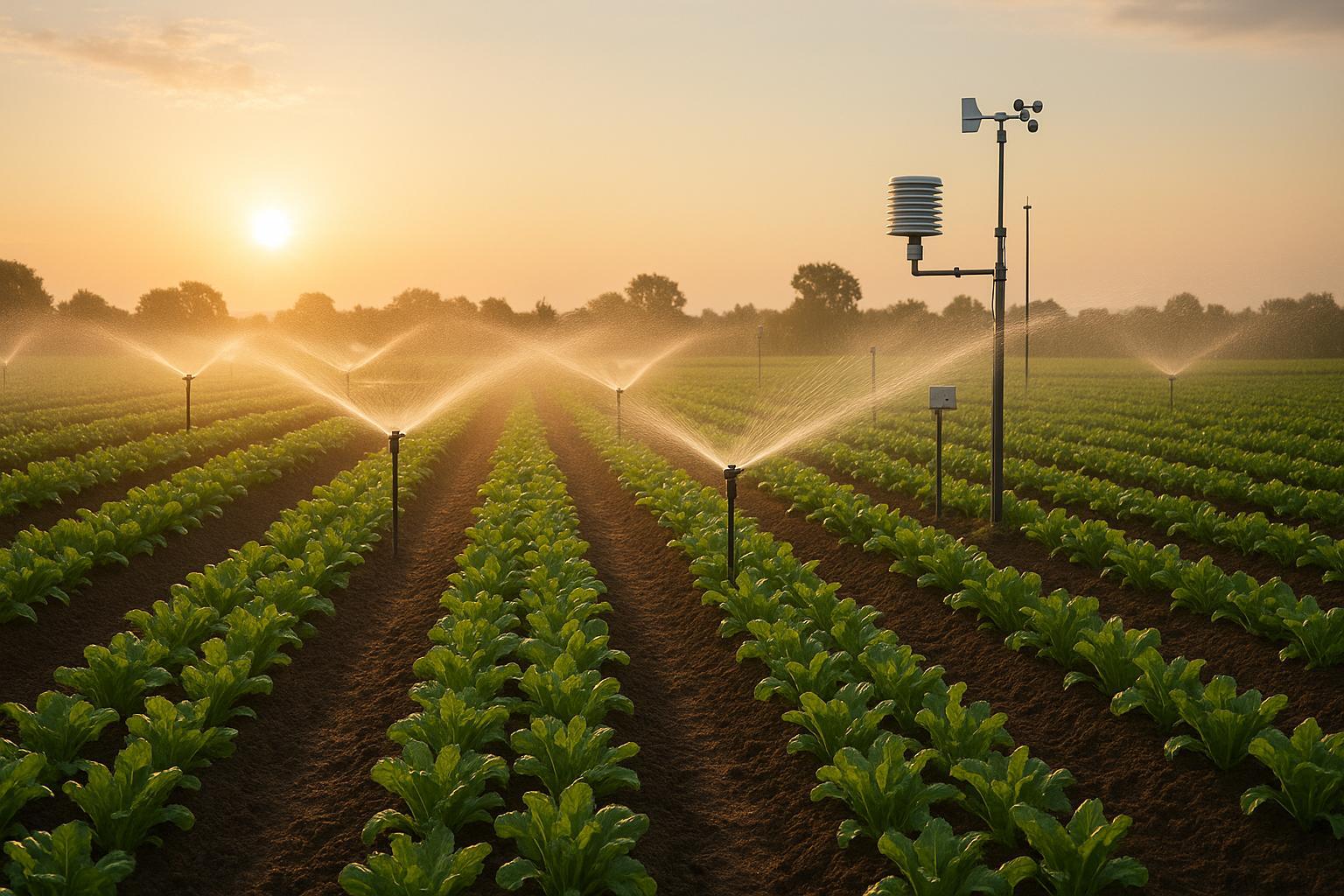
How Dynamic Irrigation Adapts to Real-Time Data
Dynamic irrigation systems utilize real-time data to optimize water use, enhance plant health, and reduce costs in gardening and agriculture.
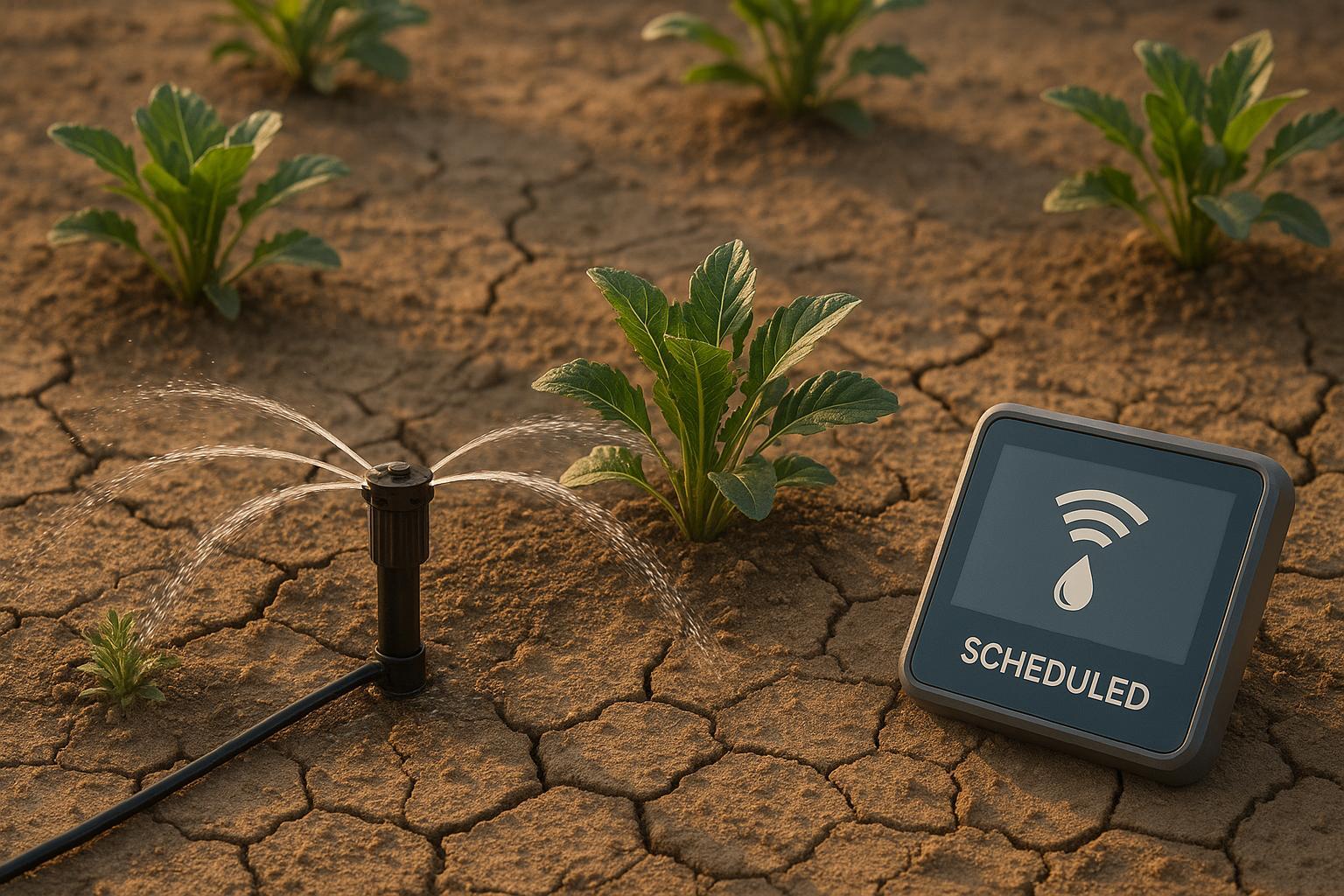
AI Watering Schedules for Drought Conditions
AI-driven irrigation systems optimize water use during droughts, improving plant health and conserving resources through real-time data and machine learning.
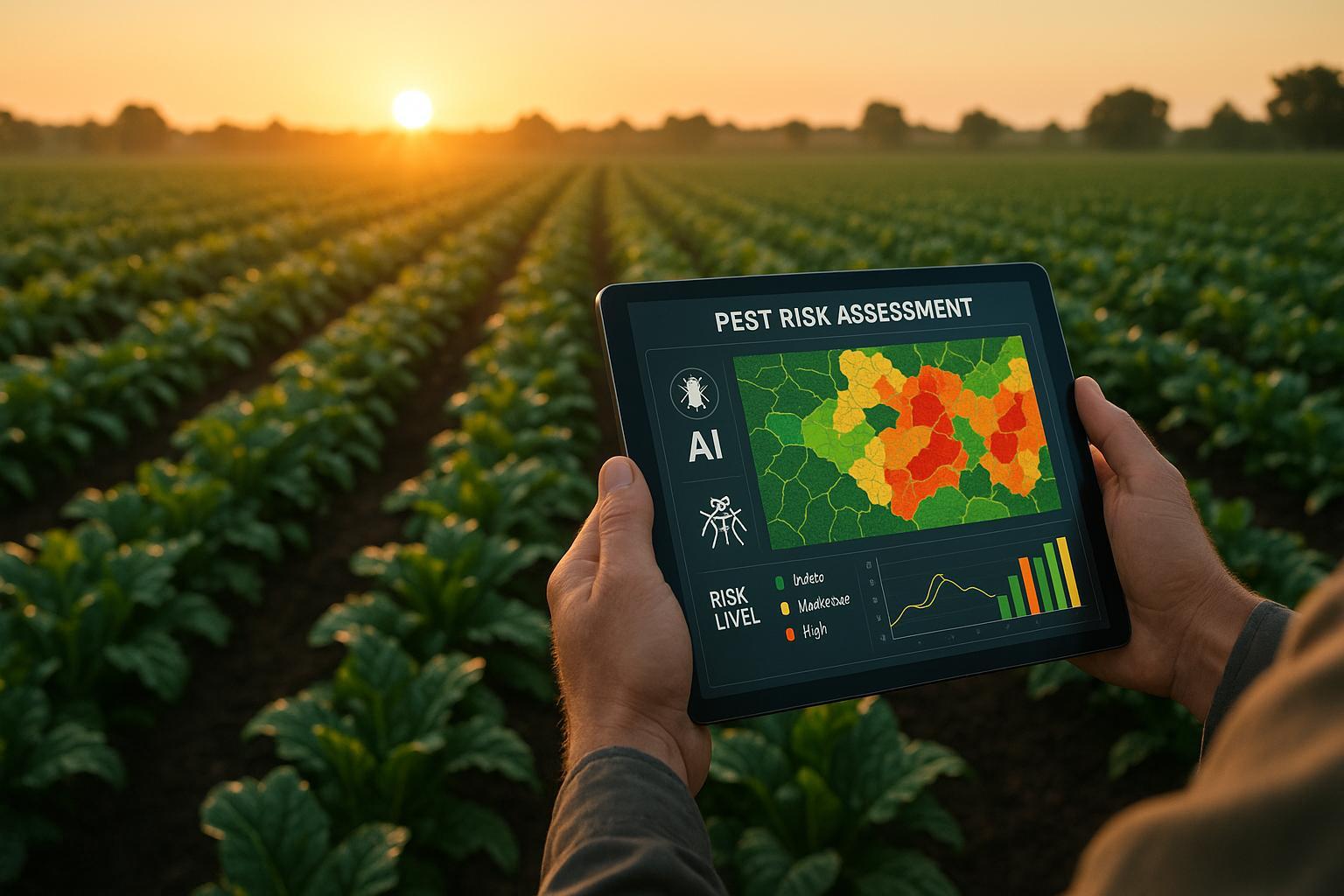
AI Tools for Pest Resistance Risk Assessment
Explore how AI tools are transforming pest management for farmers, reducing pesticide use and enhancing crop yields through advanced technology.
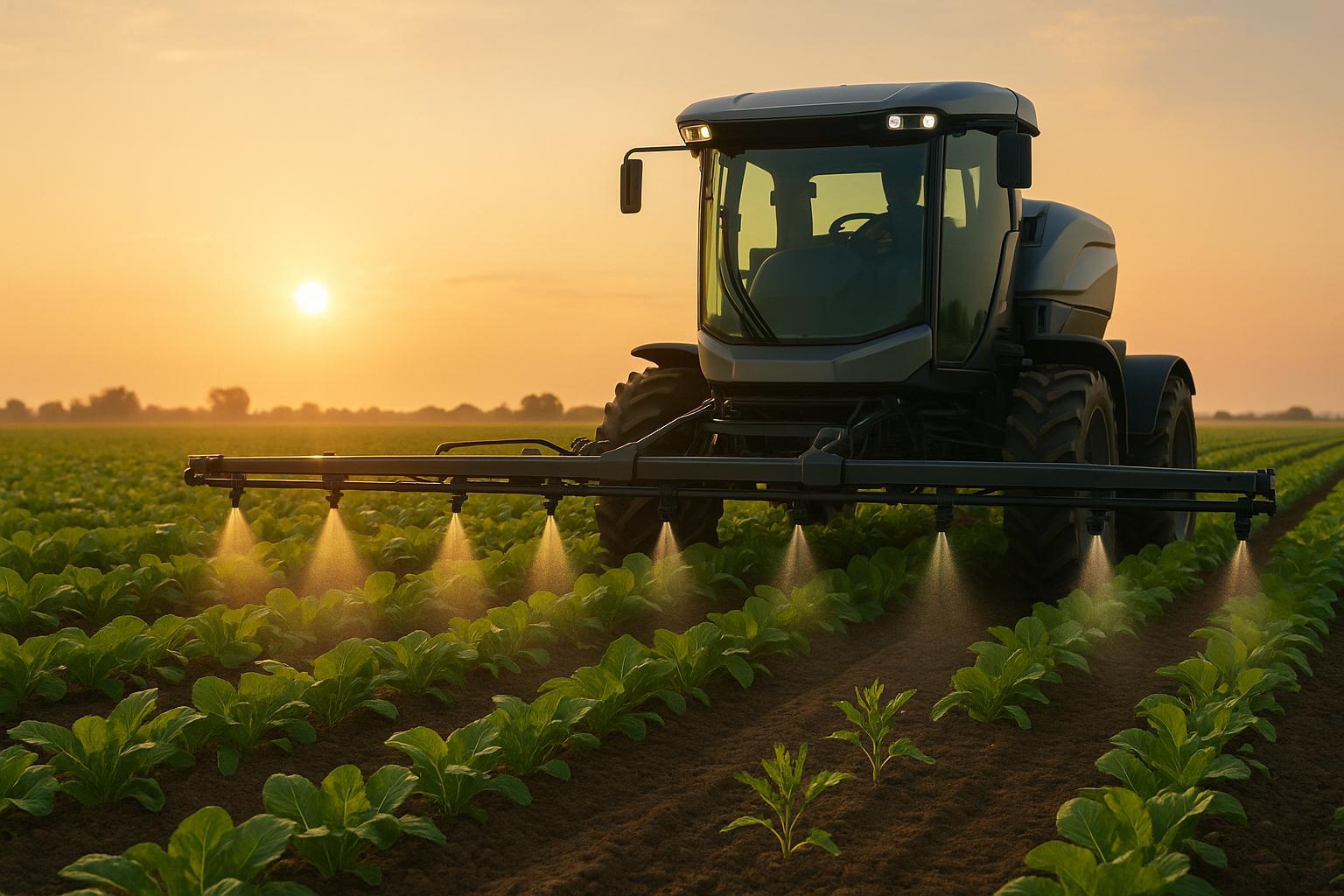
What Is Green-on-Green Spray Technology?
Explore how green-on-green spray technology revolutionizes weed control by using AI for precise herbicide application, reducing chemical use significantly.
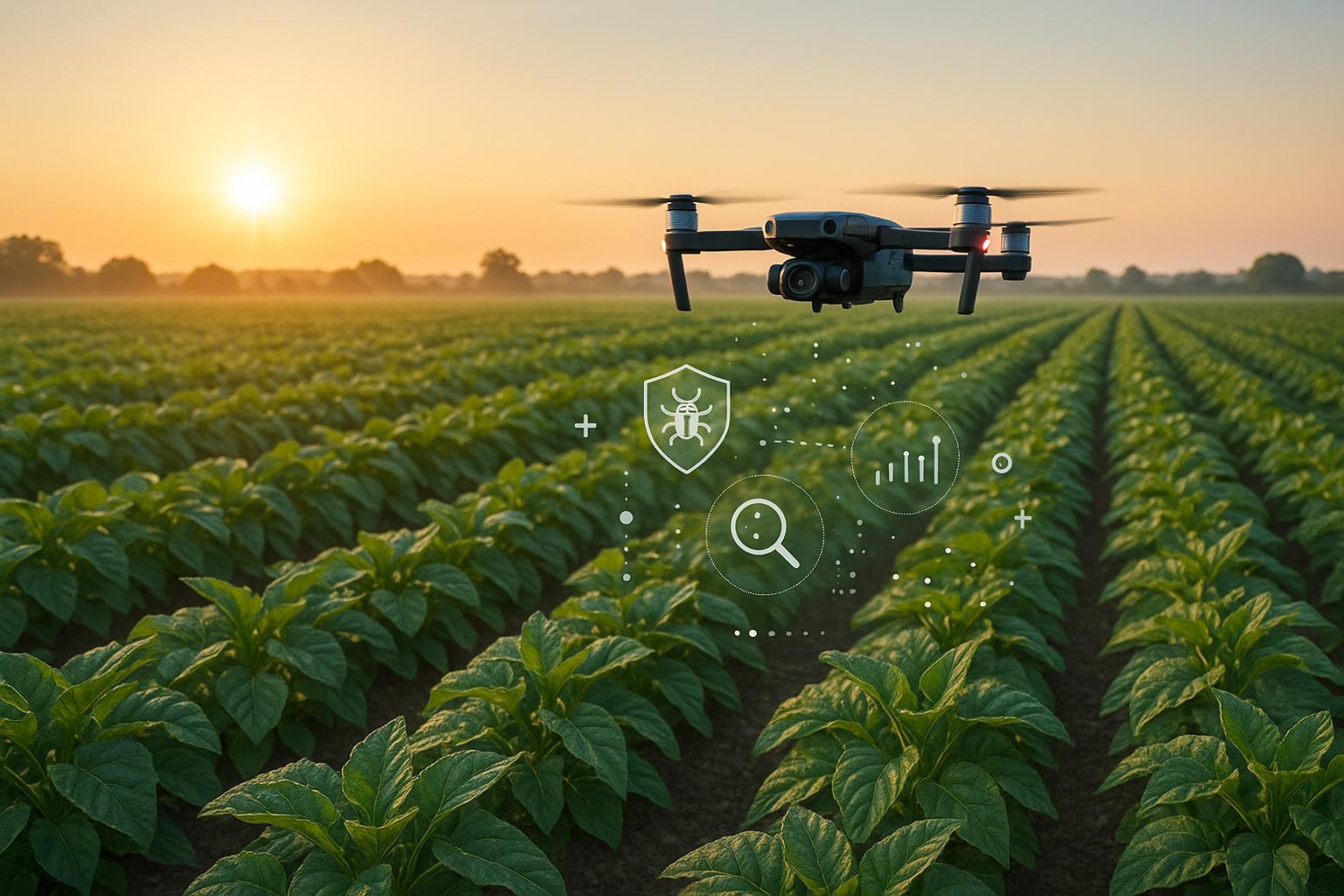
AI Pest Detection: How Early Warnings Work
Explore how AI pest detection revolutionizes agriculture by providing early warnings, reducing crop damage, and promoting eco-friendly pest management.